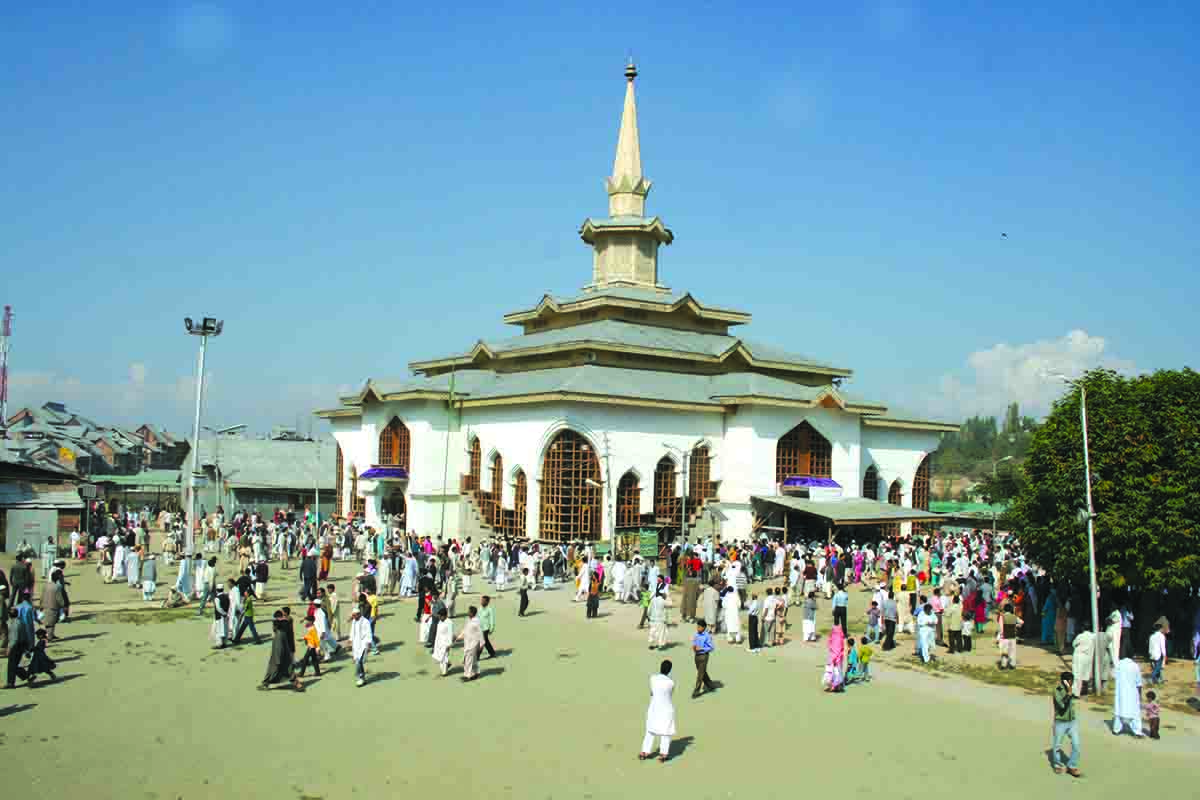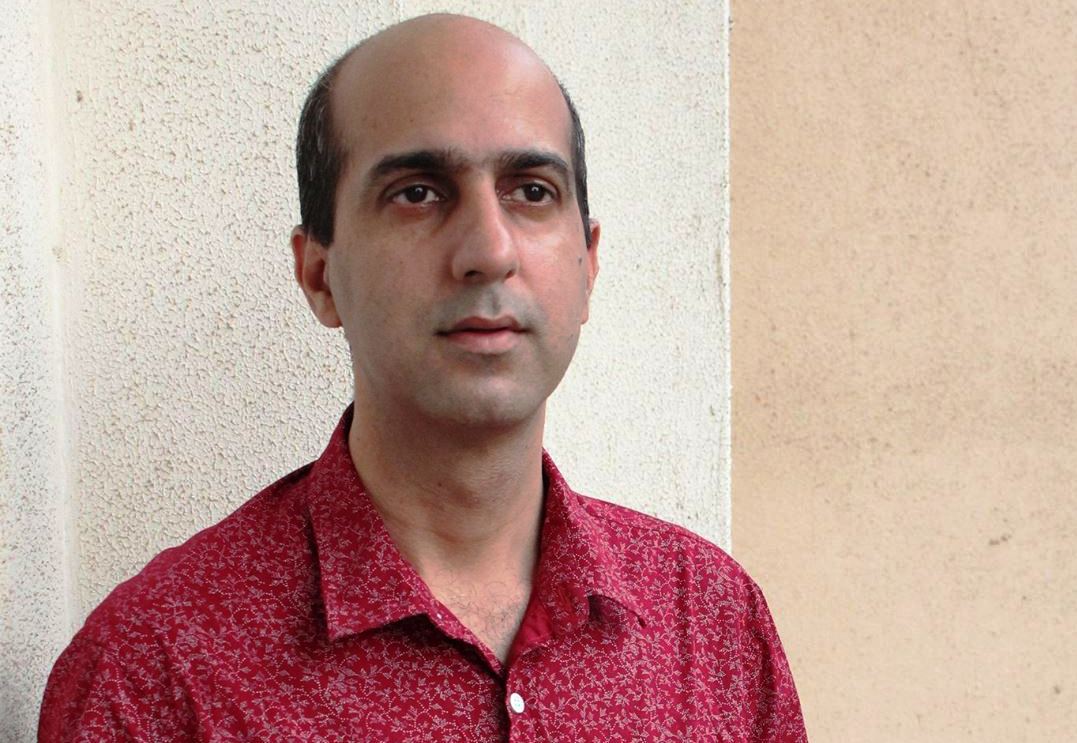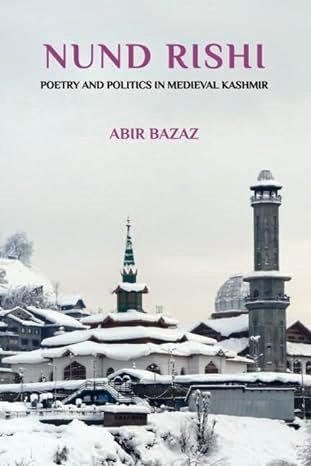A preacher, who immensely contributed to Kashmir’s transition to Islam, Sheikh Nooruddin Reshi is the least studied medieval Sufi. Muhammad Nadeem reviews scholar Abir Bazaz’s book on Kashmir’s revered standard-bearer saint that Cambridge University Press published last month

In the fourteenth century, Kashmir was ruled by the Sultans but Islam was still a work in progress. A pivotal figure who emerged during this time was Sheikh Noor-ud-Din Wali (1378-1440), also known as Nund Reshi. He came from a family of recent Hindu converts to Islam – his father, Salar Sanz, had converted under the influence of the Sufi preacher Sayyid Husayn Simnānī, the central Asian Muslim missionary, now resting in Kulgam.
Nund Reshi embarked on his spiritual journey at the age of thirty, retreating from society for twelve years of solitary meditation. In 1420, he returned and established the Rishi Order, a new Sufi movement that blended mysticism with social activism. This Order became a powerful force for change in Kashmir.
For the remaining twenty years of his life, Nund Reshi was deeply involved in the spiritual and political affairs of the Kashmiri people. His mystical poetry and teachings resonated widely and were often quoted by locals in their daily lives. He explored themes of spirituality, devotion, and the search for the Truth.
For centuries, Kashmir had been influenced by Islam from the neighbourhood. The last major effort was undertaken by Sufi mystic Mir Sayyid ‘Alī Hamadānī. He aimed to Islamise the ruling Shāh Mīr dynasty of Kashmir by promoting Islamic law and practices. However, Mir Sayyid ‘Alī Hamadānī came into conflict with Sultan Qutb al-Dīn over the pace of enforcing Islamic law. Unable to reconcile their differences, Sayyid ‘Alī Hamadānī left Kashmir.
The subsequent Shāh Mīr rulers, though, adhered closely to his teachings, signified by their wearing of his symbolic cap. His son Muhammad Hamadānī later became the leader of the Kubrāwiyyā Sufi order in Kashmir.
Emergence of Reshi
When Nund Reshi arrived on the scene, he did not engage heavily in converting non-Muslims to Islam. However, some Hindus did convert to join his Rishi Order, attracted by its spiritual teachings. The order flourished under Sultan Zayn al-‘Ābidīn, known for supporting the Rishis in his egalitarian rule. While not actively proselytising, Nund Reshi’s influence contributed to the gradual conversion of the Kashmiri elite to Islam.
In subsequent years, Nund Reshi became enveloped in myths as a saintly miracle preacher. Recent scholarship, however, aims to uncover the accurate historical and social context behind his life and poetry. Emerging academic studies focus on analysing his writings in light of the political and social events surrounding him. The texts situate his leadership role within the historical backdrop, chronicling his struggles against oppressive societal forces.
Key events in Nund Reshi’s life are scrutinised, like his meeting with his mentor Lala Arifa and his transformative encounter with Sufi master Amir-e-Kabir that reshaped his worldview and how these experiences might have influenced the formation of Reshi’s ideological and religious outlook.
Recent scholarly analysis of Nund Reshi’s life and writings dispel the aura of mythology surrounding him. They provide a more accurate picture of this prominent medieval figure who played a pivotal role in Kashmir’s transition to Islam as Sultan’s ruled. The research attempted to restore the nuance and complexity of his identity by situating his poetry and leadership within its socio-political context. This re-examination of Nund Reshi’s legacy marks an important development in reconstructing Kashmir’s medieval Islamic history.
Poetry and Politics
Abir Bazaz’s book, Nund Rishi: Poetry and Politics in Medieval Kashmir, which is the enhanced version of his 2016 dissertation, provides historical, religious, and literary context for understanding the mystical poetry of Nund Rishi. The book explores the great Rishi’s thinking on Islam through an analysis of his mystical poetry. It outlines the spread of Islam in medieval Kashmir, beginning with Arab Muslim merchants and soldiers in the ninth century.
The book argues Mongol invasions in the fourteenth century contributed to the consolidation of Muslim rule under the Shah Miri dynasty. Persian Kubrawiya Sufis, concerned with implementing Islamic law (sharia), advised the new sultans. However, tensions arose with the local Kashmiri Rishi mystics who emphasised continuity with older religious cultures.
Nund Rishi articulated an inclusive Kashmiri political spirituality that appealed to subaltern groups. He did not aim to convert Kashmiri Hindus and Buddhists to Islam. Instead, he used the Kashmiri vernacular to reach ordinary people, founding the Rishi Sufi order that spread locally across rural Kashmir. His poetry expresses a negative theology that approaches God through negation rather than affirmation. The author argues this challenges absolutist theological knowledge and political authority.
The author connects Nund Rishi’s negative theology to recurring themes in his mystical verse like death, nothingness, the apocalyptic, and diverse meanings of Islam. These themes exhibit an apophatic discourse focused on what God is not. Nund Rishi grounds Islamic technical vocabulary in the everyday lifeworlds of Kashmiris, translating and provincialising Islam for local audiences. His thinking opens inter-religious conversations between Islamic, Hindu and Buddhist traditions.
It situates Nund Rishi amidst fourteenth and fifteenth-century debates in Kashmir over Sufism’s relation to Islamic law (Shariah) and theology. Nund Rishi affirmed Shariah but also identified with Mansur al-Hallaj, who challenged orthodoxy. His poetry critiqued theological knowledge, invoked Uwaysi’s direct initiation from Prophet Muhammad (peace be upon him), and translated Islamic concepts into Kashmiri cultural idioms.
Shruk and Sahaja
One of the key themes of the book is the role of literary networks in shaping regional and trans-regional Islamic histories. As Ronit Ricci, Israeli orientalist and author of Islam Translated, notes, “Texts written in metrical verse and meant to be recited, often in public, were central to conveying and shaping cultural codes, religious doctrines, and political agendas”. This was particularly true in the context of pre-modern Islamic north India, where texts like shruks in Kashmir or kāfīs in Punjab had a similar function.

Nund Rishi was a particularly important figure in this literary tradition. As Mohammad Ishaq Khan notes, “Rishi folk literature remained in many ways the most significant medium of instruction in the values of Kashmiri society; it has had a deeper impact than mosques, madrasas and maktabs, where formal teaching was carried on”. Nund Rishi’s mystical poetry entrusts us with important questions about the relation of mystical experience to vernacular proto-modernity and the religion of the subaltern.
The book provides background on the shruk verse form used in Nund Rishi’s poetry. Shruks are quatrains or sestets that knot together compressed aphoristic insights. They have roots in older Kashmiri pada poetry and relate to South Asian genres like the doha. Shruks passed orally among audiences before being recorded in later Persian hagiographies. The author notes difficulties reconstructing Nund Rishi’s writings from these sources. It focuses on widely cited verses, favouring editions by Kamil and Saqi.
Negative Theology
The author connects the rise of negative theology in medieval Kashmir to periods of political crisis. Nund Rishi’s challenge to authority relates to vernacularisation and the transition from pre-modern to proto-modern lifeworlds. The Rishi movement attempted an alternative spiritual and political community, opposing Persian Sufi involvement with the court. The author suggests Nund Rishi’s negative theology asserts God’s unknowability and ethical concern with limits on knowledge claims. It resists nationalist or Islamist appropriations, opening possibilities for new political collectivities.
Negative theology is a discourse on the transcendent, which turns on negations rather than affirmations by approaching the question of what God is from the standpoint of what God is not. It is a long inheritance of a shared understanding of the negative path, via negativa, across faiths from ancient Asia and the Near East, Greco-Roman Late Antiquity to the Islam of the medieval Indo-Persian worlds. Negative theology eludes attempts to approach its meaning because it is precisely in escaping such a determination that it establishes its field and boundaries.
Abir analyses Nund Rishi’s poem on the attributes of a true Muslim, his critique of the mullah figure, and his identification with Mansur al-Hallaj. It discusses tensions between orthodox theology and “ecstatic” Sufism over disclosing mystical secrets. Nund Rishi cautiously defends al-Hallaj’s challenge to the Shariah while upholding Islamic law’s necessity. His thinking reveals porous borders between Shi’i and Sunni ideas in medieval Kashmir.
The author examines Nund Rishi’s asceticism and sense of the world’s impermanence. His shruks critique immersion in worldly life and express an existential dread. Nund Rishi satirises the wealthy, foregrounding death’s levelling power. His poetry reveals a social and political critique emerging through a memento mori.
Uwaysi Initiation
Uwaysi initiation is a concept in Islamic mysticism referring to a spiritual initiation that occurs without a physical teacher. It is named after Uways al-Qarani, a companion of Prophet Muhammad who attained enlightenment through direct divine experience rather than formal study.

The concept suggests spiritual enlightenment can be attained through a direct connection to God, challenging notions of spiritual lineage in Islam. Uwaysi initiation has been embraced by various mystics and theologians, including Shaykh Ahmad Sirhindi who saw it as spiritual renewal.
Uwaysi initiation is connected to love for the Prophet of Islam. This suggests it is not just a personal experience, but has broader social and political implications by empowering individual agency in the name of this love.
Nund Rishi’s poem tracing the Rishis’ lineage to the Prophet and Uways al-Qaranī is examined for its assertion of Islamic and Kashmiri continuity. Calling the Prophet Muhammad the first Rishi situates him among legendary Kashmiri sages.
Rahi’s Readings
Abir analyses Nund Rishi’s thinking on death through close readings of his mystical poetry. It draws on the Kashmiri critic Rahman Rahi’s seminal essays interpreting death as the fundamental theme in Nund Rishi’s shruks. The author connects this to Islamic ideas of mortality and strands of existential thought.
Rahi’s essays outline the poetics of death in Nund Rishi using vivid metaphors. Death abruptly interrupts life and paralyses existence. Nund Rishi’s shruks convey encounters with death’s inevitability. His poetry registers death’s omnipresence – in shattered youth, abandoned shops and cracked clay vessels. Nund Rishi affirms Islamic afterlife beliefs but repeatedly stresses death’s universality.
Abir also analyses Rahi’s comparative readings of Nund Rishi and Lal Ded. It traces his attempt to reconcile mysticism and poetry in interpreting Nund Rishi’s uneven verses. Rahi struggles to isolate literary judgment from Nund Rishi’s mystical stature. He insists on reading Nund Rishi’s corpus on literature’s own terms. The author suggests this pushes toward negative theology as discourse on death.
Abir relates Nund Rishi’s existential mood to Heidegger’s philosophy. Both counterpose mortality’s certainty to rational certitudes. Abir suggests Nund Rishi’s call to die before you die and face death is connected to Heidegger’s concept of being-toward-death as Nund Rishi’s poems reveal an impassioned freedom toward death and refusal of idle talk about mortality.
Parallels are drawn between Heidegger’s anxiety in the face of death and existential dread in Nund Rishi. Nund Rishi’s depictions of death are interpreted not as a morbid obsession but as an attempt to shake off its denial in everyday life.
The relation of Nund Rishi’s existential views to traditional Islamic ideas of death is explored. Nund Rishi advances an existential understanding of death while invoking Islamic eschatology.
The author notes that in the Quran, death is seen as a moment of transition, reckoning, and catastrophe leading to an afterlife. However, Abir claims, Nund Rishi goes beyond merely affirming faith in the afterlife to present death as an existential encounter that can transform one’s life.
Nund Rishi frequently calls upon his readers to die before you die, which the author connects to Sufi ideas of ego annihilation and spiritual transformation before physical death. Dying is presented not just as an event at the end of life, but as an ongoing practice of self-knowledge and ethical development. The author situates this within broader ascetic traditions like Buddhism that also encourage the contemplation of mortality.
Death
One of the key contributions in this chapter is how Nund Rishi links his existential vision of death to political concerns. His call to continually die and be reborn is aimed at creating a new ethical subject and political community less bounded by fear. The author argues this invented tradition of death in Nund Rishi resists the dominant political culture of medieval Kashmir. Abir provides a nuanced analysis of how mystical poetry engaged with philosophical questions of existence and subtly addressed society.
Rahi’s metaphorical interpretations are examined and his analyses fill in absences within the shruks. But the author finds Rahi seeking unity where the verses reveal knotty antinomies. The chapter explores debates over Nund Rishi’s relation to Lal Ded’s poetry. It notes the Kashmiri tradition’s memory of an abstract affiliation between them.
Unjust Political Orders
In the third chapter, Abir offers an analysis of the apocalyptic themes in the mystical poetry of Nund Rishi. It situates Nund Rishi’s apocalypticism in the context of the Abrahamic religious traditions, arguing that he translated and vernacularised the classic Islamic apocalypse. The author contends that Nund Rishi’s apocalyptic shruks mediate the relations between pre-Islamic and Islamic eschatology while deploying traditional Muslim apocalyptic critiques against the new Muslim sultanate of medieval Kashmir.

The chapter opens by defining apocalyptic literature as dealing with end times and the ends of human life and history, with origins across Judaism, Christianity, and Islam. It notes how the genre frequently emerges on the margins and during times of crisis. The author then provides a close reading of a shruk by Nund Rishi depicting the cataclysmic end times, arguing it exemplifies key features of the Qur’anic apocalypse like mountains blowing away and moral dualism between good and evil.
The author contends Nund Rishi creatively translated classic Islamic apocalyptic materials into the Kashmiri vernacular for his historical situation, marked by Mongol destruction and tensions between Hindus and Muslims. Unlike much Sufi poetry, Nund Rishi’s apocalypticism is aimed not at a deferred eschatological end of history but at ending unjust political orders. The author provides numerous examples of shruks critiquing authorities and inequality. There is also tension between the ascetic apocalypse and revolutionary Muslim apocalyptics.
Abir delineates differences between the traditional Muslim apocalypse stressing moral decay and the Sufi apocalypse of inner transformation. For Nund Rishi, the end times are intimate hope and rebirth. His vernacular apocalypse challenges Indo-Iranian notions of authority in the name of subaltern justice, consonant with bhakti saints. The chapter concludes by relating Nund Rishi’s apocalypticism to utopian imagination and an emergent non-religious religiosity. This is a scholarly examination revealing the rich socio-political meanings encoded in mystical poetry.
Bhakti and Sufi Conundrum
In the conclusion, Abir sums up the key arguments and findings of the book. The author begins by reflecting on how Nund Rishi’s negative theology posed a challenge to the politically dominant positive theology of Persian Sufis while also questioning the new Muslim sultanate of medieval Kashmir. This mirrors the frequent tensions between mystical poetry and political authority in Islamic societies. Nund Rishi’s turn to an unknowable God opened interreligious dialogues and new inclusive political imaginaries in Kashmir, akin to other syncretic bhakti-Sufi figures.
The author contends reading Nund Rishi is urgent for contemporary Kashmir, still divided over questions of religion and politics. While reified notions of God appear in the poetry, there is also an “unsaying” that gestures to alternative political thinking foregrounding mortality, negation, temporality, and faith. Nund Rishi creatively reinterpreted Islamic tradition without outright rebellion.
The confusion arrives when the book advocates approaching Kashmiri mystical poetry as significant to Indian thought which is alien to this, not just literary studies. Though the bhakti saints can be linked to Kashmir’s pre-Islamic past, it doesn’t necessarily define the genesis of Sufi poetry with rebellious undertones.
Conclusion
The author acknowledges the limitations of this initial study, noting several underexplored themes in Nund Rishi like nafs, ishq, ilm, and faqr. A comprehensive analysis would necessitate even greater interdisciplinarity engaging fields from history to philosophy and command of multiple South Asian languages. Nonetheless, the book makes a valuable contribution by highlighting the cultural resources within Nund Rishi’s poetry and offering clues to alternative Kashmiri futures. The author expresses hope that Nund Rishi’s legacy as Kashmir’s ‘alamdar can be reimagined for emancipatory ends.















